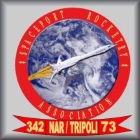
|
Spaceport Rocketry
Association
Premier rocketry
organization serving the Florida Space Coast since 1973
|
|
Spaceport Rocketry Association
Educational Information
|
|
A mission of SRA is to aid and
encourage by all suitable means all people interested in sport,
amateur and experimental rocketry, and its related sciences, in
a safe, fun and enjoyable family environment. The SRA has a long
and proud heritage of supporting student groups and activities.
|
|
Rocketry
Educational Information - This is rocket science!
|
|
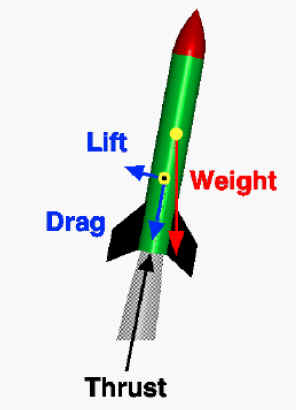
|
Forces on a Model Rocket
Flying model rockets is a
relatively inexpensive way for students to learn the basics of
aerodynamic forces and the response of vehicles to external
forces. Like an aircraft, a model rocket is subjected to the
forces of weight, thrust, drag, and lift.
|
|
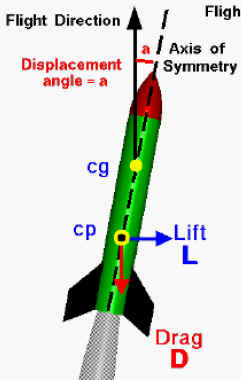
|
Fundamentals of Rocket Stability
Following the liftoff the rocket
often turns into the wind. This maneuver is called weather
cocking and it is caused by aerodynamic forces on the rocket.
During the flight of a model rocket small gusts of wind, or
thrust instabilities can cause the rocket to "wobble", or change
its attitude in flight. When disturbed by external forces a
stable rocket will always tend to return to it's original flight
path.
|
|
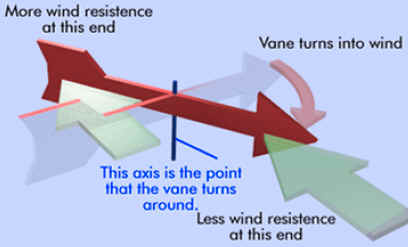
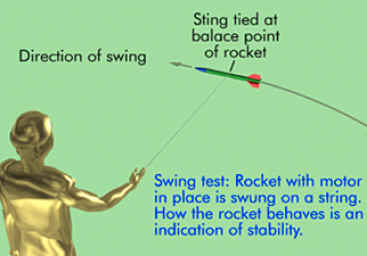
|
Model Rocket Stability: The Basics
The principle of air pressure
blowing against an object and causing it to turn is well
demonstrated by a weathervane. The swing test is a basic test to
give you a rough idea how your model rocket will fly.
|
|
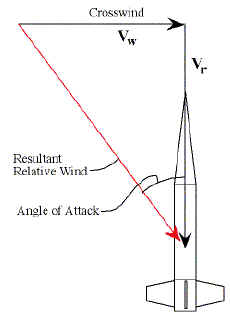
|
Wind Caused Instability
Rocketeers intending to fly on
windy days should learn more about their rocket's stability than
merely whether or not the CG is at least 1 caliber forward of
the CP. It is not a good idea to launch rockets in winds between
about 15 mph and the 20-mph limit unless their stability
characteristics are particularly favorable for these conditions.
|
|
Download OpenRocket
|
Don't have a wind tunnel handy
to check your rocket stability? No problem, today's technology
enables us to run sophisticated rocket simulation on the typical
desktop computer. OpenRocket is a
free, fully featured model rocket simulator written in Java. It
can be used to design and simulate rockets before actually
building and flying them. OpenRocket features a full
six-degree-of-freedom simulation, realistic wind modeling, a
multitude of different components including free-form fins and
canted fins, clustering and staging.
|
|
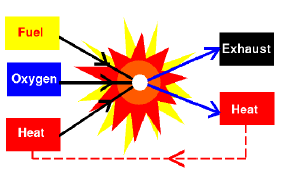
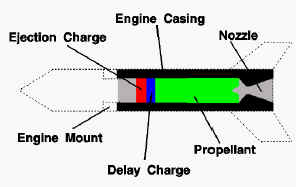
|
Fundamentals of Rocket Motors
To move a model rocket through
the air, we must use a propulsion system to generate thrust. All
rockets rely on some type of engine to generate power. Rocket
engines depend on the burning of fuel to produce power. There
are two main categories of rocket engines; liquid rockets and
solid rockets. In a solid rocket, the fuel and oxidizer are
mixed together and packed into a solid cylinder.
|
|
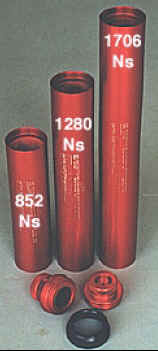
|
High Power Rocket Motor Basics
Reloadable solid rocket motors
basically consist of a motor casing which is lined with heat
resistant material and filled with a combustible propellant. The
propellant is burned to provide high volumes of expanding gases,
which are accelerated through a nozzle at one end of the motor
to provide thrust according to Newton's third law. The motor
casing contains these very hot expanding gases so that they can
be directed towards the nozzle.
|
|
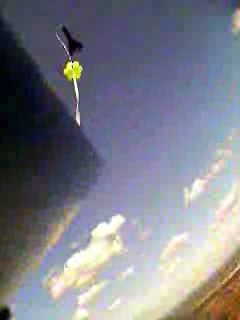
|
Dual-Event Recovery
Information
Two-event recovery is electronic based apogee (drogue) and main
recovery. It adds complexity to the rocket, increases the cost,
and increases the rocket preparation time. However, these
disadvantages are quickly overcome by the desire to decrease
recovery time (and therefore drift) as the rocket altitude
increases.
|
|
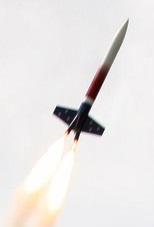
|
Motor Clustering Information
Motor clustering
is the use of more than one motor fired at the same time.
Clustering adds together the thrust level, and thus the lifting
or pushing power, of all the motors used. This makes it a good
technique for lifting heavy payloads and large rockets.
|
|
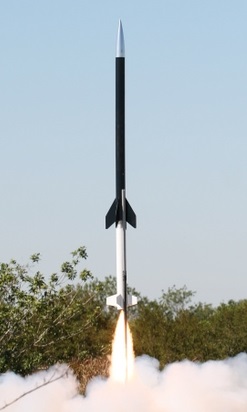
|
Motor Staging
Information
Motor staging is the use
of more than one motor, each fired in sequence, and typically
with each motor (stage) being discarded after it is used.
Staging extends the thrust time which makes this technique
especially effective for achieving higher altitudes.
|
|
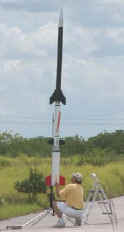
|
Anatomy of a Successful Failure
High power rockets are capable
of causing significant damage yet the High Power Rocketry hobby
has an excellent safety record. "Anatomy of a Successful
Failure" was an article written by one of our members that shows
safety is no accident.
|
|
Rocketry Educational Web
Sites
|
|
Beginner's Guide to Rockets
|
The
Beginner's Guide to Rockets will help you learn the basic math
and physics that govern the design and flight of rockets. At
this Web site you can study how rockets operate at your own pace
and to your own level of interest.
|
|
Beginning Model Rocketry
|
This
site is for anyone interested in space, rockets, and model
rocketry. These pages will give you some background on the
hobby, hopefully answer some questions, and get you started on
your way to becoming a rocketeer.
|
|
HobbyLinc Guide to Model Rockets
|
HobbyLinc has a guide to model
rockets that includes everything from the anatomy of a model
rocketry, to choosing, building and launching your own rocket.
|
|
Rocketry
Online INFOcentral
|
The
online rocketry resource. Designed to assist old and new
enthusiasts alike, They present commonly referenced
industry terms and definitions together with graphical
representations of the subject matter.
|
|
r.m.r FAQs
|
The rec.models.rockets (r.m.r)
list of Frequently Asked Questions (FAQs) is an attempt to
compile a number of questions and suggestions into a single
document. Although this document is not a 'how to' on any form
of rocketry, it's hoped that it might be of use in answering
some of the more commonly asked questions, summarizing some good
tips and suggestions, and directing the reader to other
documents, books, sources, etc., where more information may be
found.
|
|

|
Rocketry Educators Pack
by Apogee Rockets
In
this document, you’ll find a stockpile of resources that you can
use in your rocketry unit at school. There are great things like
overhead transparency images, handouts, award certificates,
coloring pages, and quizzes that you can print out and give to
your students. Pick and choose what works for you; the overhead
transparencies will also work great in PowerPoint presentations!
|
|

|
Rocketry Educators Pack by NASA
The
Rockets Teacher Guide builds on classroom experience and
presents a suite of improved and activities that prepare
students for the future of space exploration. It has found
widespread use because of the exciting nature of the topic and
because of its dynamic classroom activities that match and
support both national and state education standards for science,
mathematics, and technology. This revision of the guide, by the
original authors, updates educators on NASA’s 21st Century Space
Exploration Policy and the vehicles that will make this vision
possible.
|
|
Student Rocketry Competitions
|
|

|
Team
America Rocketry Challenge (TARC)
TARC gives students
opportunities to apply their math and science skills to a real
world project outside of the classroom. For many students,
this experience yields their first significant personal
realization of how what they are learning in school is relevant
to endeavors that are fun, challenging, and represent potential
future career pathways. Through TARC, students have
discovered that they enjoy solving math and science problems in
the context of resolving difficult and complex design issues.
Often TARC is also their first exposure to the aerospace
industry. They learn what aerospace engineers and skilled
technical workers do and what it takes to become one of those
professionals.
|
|

|
Rockets For Schools
Rockets for Schools provides an opportunity for students to
learn about aerospace technology, scientific experiments, and
space launches. Student teams construct a rocket equipped with a
powerful motor that lifts it to high altitudes. Besides
constructing their rocket, students design a payload experiment
to fly on their rocket. In addition, students give an oral
presentation and prepare a visual display of their experiment to
exhibit at the event.
|
|

|
Student Launch Initiative
The NASA Student Launch
Initiative (SLI) involves middle and high school students in
designing, building and testing reusable rockets with associated
scientific payloads. This unique hands-on experience allows
students to demonstrate proof-of-concept for their designs and
gives previously abstract concepts tangibility. Teams can
qualify to participate in the SLI by placing in the top level
two teams at the Rockets for Schools competition or by placing
in the top at the Team America Rocketry Challenge, or TARC.
|
 |
The
Intercollegiate Rocket Engineering Competition
The World's Largest
University Rocket Engineering Competition
ESRA hosts an
Intercollegiate Rocket Engineering Competition
(IREC) for student rocketry teams from across
the USA and around the world. With a payload
size of 8.8 pounds and target altitudes of
either 10,000 or 30,000 ft. above ground level,
competing rockets are typically 4 to 8 inches in
diameter and 8 to 20 ft. long. Multistage
rockets and all chemical propulsion
types (solid, liquid, and hybrid) are allowed.
|
|
Copyright© 2020
All Rights Reserved
|
|
















